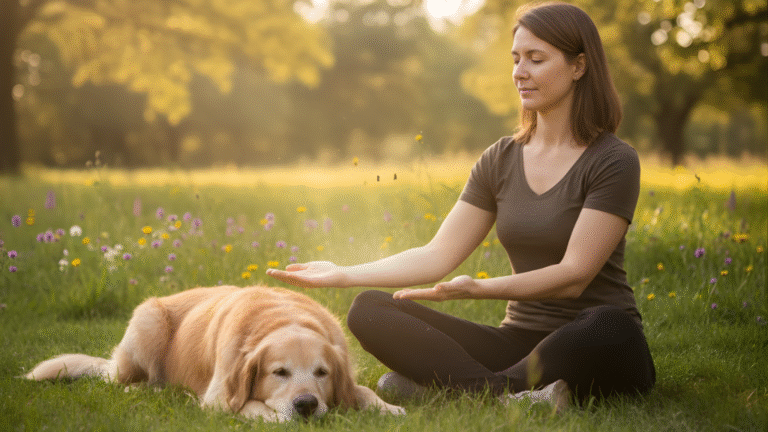How To Use Reiki To Support Your Pet’s Recovery From Surgery
Supporting your pet through recovery after surgery can feel overwhelming, and if you're like me, you probably look for every way possible to help your furry buddy feel better.
Reiki is a gentle, hands-on (or even hands off) energy technique that a lot of pet parents use to give their pets some extra comfort and peace during this time.
If you’re curious about how Reiki can play a role in your pet’s healing adventure, here’s a straightforward guide to how it works, what to expect, and how you can get started—even if you’re a complete newbie.
Did you know that many pet parents combine their love for animals and Reiki into thriving blogs and businesses? 🐾 Discover how inside Wealthy Affiliate.

What Is Reiki, and Why Use It for Pets?
Reiki has been around for about a century and is rooted in Japanese traditions. Its main idea is that a practitioner can channel healing energy into a person or animal by using light touch or by hovering their hands near the body.
For pets, Reiki sessions feel calming and can help lower stress, speed up the relaxation process, and even give their immune system a gentle nudge during recovery.
Many people use Reiki to support pets facing all sorts of challenges, but it’s especially useful after surgery.
It doesn’t replace proper medical care or vet checkups, but it can be a helpful extra support option.
Research is still growing, but plenty of pet parents and some holistic vets report that Reiki seems to help pets deal with discomfort, anxiety, and the little hurdles that pop up after surgery.
If you’re hoping for an extra dose of relaxation for your animal, Reiki might be just what you need.
Preparing to Use Reiki for Your Pet After Surgery
Before bringing Reiki into your pet’s post surgery routine, it’s really important to check in with your veterinarian.
Reiki is safe, but always make sure any complementary approach fits well with your vet’s recovery plan.
The next step is to think about what kind of Reiki practitioner you want to work with—or if you want to learn some basics for use at home.
Certified Reiki practitioners who specialize in animals can often do in person or distance (remote) sessions, depending on your location and comfort level.
If you’re interested in trying some techniques yourself, a short course or an online tutorial is a good way to pick up the basics, even if you’ve never done anything like Reiki before.
- Certified practitioners: Look for someone with experience working with animals, and don’t hesitate to ask questions about their training or background.
- Learning the basics: Short online courses and local classes teach simple hand positions and ways to use intention to help your pet relax.
- When to start: Wait until your pet is stable after surgery and cleared by your vet to receive gentle touch or energy work.
How a Typical Reiki Session Looks for a Pet in Recovery
Every Reiki session is a little different because it’s really all about your pet’s comfort. Here’s a quick rundown of what usually happens during a session:
- Sessions typically last 15 to 30 minutes, especially if your pet is new to Reiki or still feeling groggy post surgery.
- Your pet stays in a safe, comfy spot, sometimes in a favorite bed or right beside you.
- The practitioner gently places their hands on or near your pet, or keeps their hands a few inches away if your pet doesn’t want to be touched.
- Distance Reiki is another option where the practitioner sends calming intentions without being physically present. This is great for animals who are skittish or need quiet.
- Pets often relax, drift off, or just quietly soak in the calm. Others might sniff around, get up, or even walk away. This is totally normal, and it means your pet is guiding the experience for themselves.
Step by Step Guide: Simple Reiki Techniques You Can Try at Home
Curious to give Reiki a try yourself? Basic self taught Reiki is safe and quite easy to incorporate into your pet’s recovery time. You don’t need to have advanced training to start with gentle, caring, and mindful touch.
- Set the mood: Choose a quiet spot. Dim the lights or play soft music. The goal is to keep things peaceful.
- Stay calm and focus: Take a few deep breaths and set a gentle intention, like “I hope you heal and feel comfortable.”
- Hands on (or hands near) touch: Rest your hands lightly on your pet, either directly or just above their fur. If there’s a surgery site, keep your hands nearby but not directly on the incision unless your vet says it’s okay.
- Keep sessions short and sweet: Even a few minutes can go a long way, especially if your pet is tired. Watch your pet’s response. If they seem to enjoy it, you can continue a bit longer. If they move away or seem restless, try again later or switch to a more distant approach.
- Close with gratitude: End by thanking your pet for sharing the moment. A simple “thank you” or a treat never hurts here!
Things You Should Probably Consider Before Using Reiki for Pets
Like anything new, there are a few things to keep in mind when using Reiki for post surgery pet recovery:
- It’s not a replacement for vet care: Reiki works alongside surgery recovery, but your vet’s guidance always comes first.
- Comfort is everything: Some pets love hands on attention, while others might want their own space. Let your pet’s signals guide each session.
- Patience helps: Don’t worry if your pet doesn’t settle right away. Recovery can be a stressful time, and every animal responds differently.
- Consistency brings benefits: Short, regular sessions work better than long or infrequent ones. Try a quick five minute practice daily or every other day.
- It doesn’t interfere with meds or procedures: Reiki is gentle and noninvasive, so it’s safe to use alongside medication, physical therapy, or other treatments your pet might need.
Making Your Pet Comfortable During Reiki Sessions
Setting up a stress free spot for Reiki time helps your pet feel safe. Some folks use special pet beds, cozy blankets, or favourite toys.
You can sit beside your pet or keep a little distance if your animal prefers alone time. The point is to give your pet the choice to participate or leave whenever they want.
How to Tell if Reiki is Helping
You’ll notice positive changes with regular practice. Pets who benefit from Reiki often seem more at ease, sleep more soundly, or show signs of gentle energy (like a calm tail wag or a brighter face).
The changes may be small, but even a softer sigh or fewer anxious movements means the practice is working for your buddy. Watch for little shifts—sometimes it’s the smallest changes that signal big progress.
You might also see improved appetite or a willingness to socialize more between rest periods, which can be encouraging signs!
Cool Tips for Getting the Most Out of Reiki in Pet Recovery
To bring some extra benefit to your pet’s Reiki sessions, here are a few ideas to try out:
1. Practice at the same time each day
This helps build routine and comfort for both you and your pet. Keeping consistency also helps your pet anticipate the session and become more comfortable with it over time.
2. Use soothing scents (sparingly!)
Some pets enjoy soft aromas like lavender, but always check with your vet and use pet safe options only. Avoid essential oils for cats, and be careful with open flames or diffusers. A gentle scent can sometimes give a boost to the relaxation effect, but watch for any signs of irritation.
3. Record your pet’s progress
Jot down little improvements, moods, or reactions after each session. This is a super simple way to track what’s working and to share updates with your vet or Reiki practitioner. Keeping notes also helps spot trends over time that you might otherwise miss.
4. Invite other family members
If your pet is comfortable, quiet Reiki sessions with the whole family can help strengthen bonds and give your pet some extra reassurance. Including trusted people can help your pet feel more secure during recovery and can turn the session into a calming ritual for everyone.
5. Add in gentle massage
Once your vet approves, gently stroking your pet’s coat or giving a light rub (away from the surgery site) during or after Reiki can help with circulation and deepen the relaxation response. Always move slowly and watch your pet’s signals for guidance.
6. Keep other stressors low
During recovery, try to minimize loud noises, strangers, or sudden changes that could add stress. Creating a calm environment supports Reiki and your pet’s healing as a whole.
Frequently Asked Questions About Reiki for Pets After Surgery
Here are a few questions that come up all the time when folks want to learn about using Reiki during a pet’s surgical recovery:
Question: How soon after surgery can I start Reiki for my pet?
Answer: It’s best to wait until your pet is stable and cleared by your vet. For some pets, this is just a day or two after surgery, for others, it could be a week or more. Always follow your veterinarian’s advice.
Question: Does my pet have to sit still for Reiki to work?
Answer: Not at all. Some pets nap or stretch out, while others may get up and move around. Just let them decide what’s comfortable, Reiki isn’t disrupted by their natural movements.
Question: Can I combine Reiki with other holistic therapies?
Answer: Yes, many pets benefit from a combination of gentle therapies, including acupuncture, massage, or aromatherapy (as long as these are safe for your pet). Just check with your vet before making changes to your pet’s care plan.
Question: Is distance Reiki really effective for animals?
Answer: A lot of pet owners and practitioners find that animals respond really well to distance sessions, especially if they’re anxious about strangers or just prefer quiet time alone.
You don’t need to be physically present to offer calming, loving intentions through Reiki. What matters most is your caring focus and positive intention toward your animal, which can be effective from afar.
Bringing Reiki Into Your Pet’s Overall Recovery Plan
Having tools to help your pet feel better as they recover from surgery is super useful. Reiki is gentle, flexible, and can be done right at home or by working with a professional.
For those who want to try something calming and supportive, without side effects or complicated routines, Reiki is worth checking out.
Keep your vet in the loop, stay patient with your pet’s process, and don’t forget to enjoy these quiet moments of connection. Recovery takes time, but with a little extra care and a few mindful Reiki minutes, you’re giving your pet a comforting boost as they heal.
I trust you enjoyed this article on How To Use Reiki To Support Your Pet's Recovery From Surgery. Please stay tuned for more Reiki insights, pet wellness tips, and holistic lifestyle ideas.
Take care!
— JeannetteZ
💬 Your Opinion Is Important To Me
Do you have thoughts, ideas, or questions? I’d love to hear from you. Please leave your comments below or email me directly at Jeannette@pawreiki.com.
🐾 More PawReiki Reads
💜 My #1 Recommendation for Online Success
Reiki has been life-changing for me, and I love sharing it online. If you’ve wondered how Reiki lovers turn their passion into income, this platform is the best place to start.
🌟 See How Reiki Lovers Build Online Income — Try WA FreeDisclosure
This post may contain affiliate links. I earn from qualifying purchases at no extra cost to you. Please read my full disclosure.







